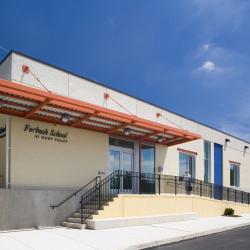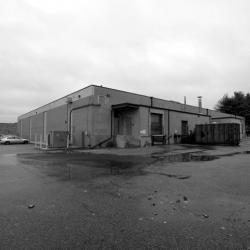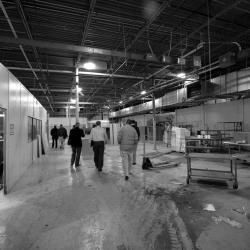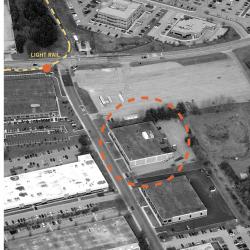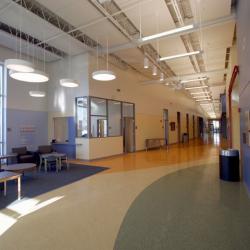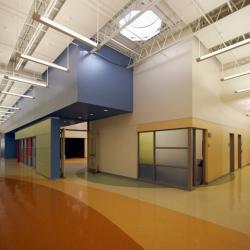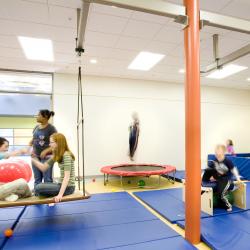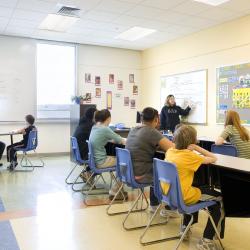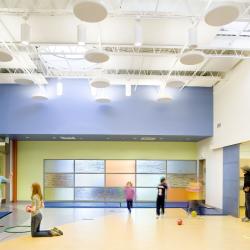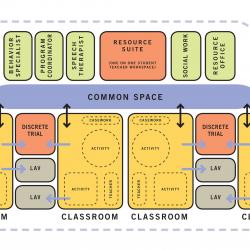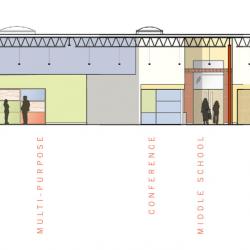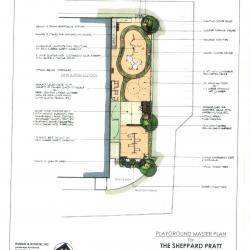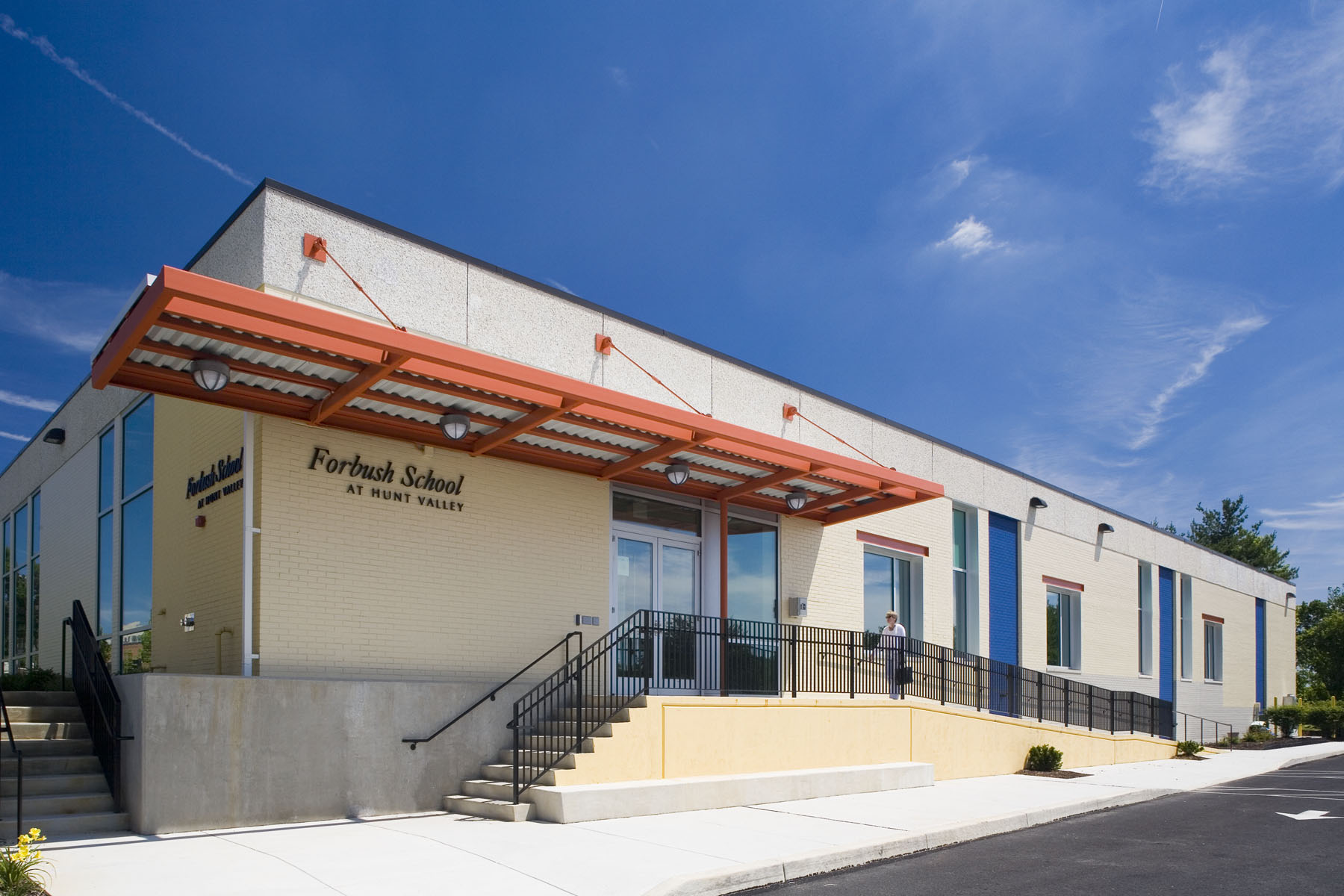
Introduction
Office parks are among the underused and unloved built environments littering the suburban United States. This is the story of one of buildings remarkably transformed into a private school providing educational and theraputic services for children ages 5-21with autism spectrum disorder (ASD). Located just outside of Baltimore in Hunt Valley, Maryland, the Forbush School, part of the Sheppard Pratt Health System, was opened in 2008 in what had been an unused warehouse in an office park. The school was quickly filled to capacity with 72 students and 60 staff. Cho Benn Holback of Baltimore transformed the utterly undistinguished warehouse into a welcoming and innovative educatational community conducive to the unique learning and complex developmental needs of children with ASD. Capacity enrollment and superlative testimonials about the new school measure this unsual adaptive reuse as a success.
Description
While the original brief for the project was to design and construct a new 30,000 square foot school to replace an over-crowded and out-dated school on the campus of the Sheppard Pratt Health System in Baltimore. The existing private school served a mix of over 200 children about equally distributed between those with behavioral health disorders and autism spectum disorders (ASD). The children came from many different school districts and were deemed unable to learn successfully in integrated classrooms in their own districts. A realization that children with ASD needed a different learning environment from the children with behavioral health disorders, combined with budget cuts and time constraints, necessitated an alternative to the original plan.
The surprising solution was to lease an existing one-story 1960’s era warehouse building and its surrounding site in Hunt Valley, Maryland and reinvent it as a welcoming school. The single-story structure, size, low cost, and easy access to dominant travel routes in this part of Baltimore County made it a viable option. Not only was the interior renovation a challenge, but the design team at Cho Benn Holback + Associates, Inc. had to renovate the surrounding site to provide needed vehicular access, parking, and appropriate outdoor playground space for the school.
The new school contains classrooms, staff offices, therapy spaces, and a specially designed playground to meet the needs of children with ASD. Ramps are incorporated into the main and playground entries. Classrooms have accessible bathrooms and the rubber-padded linoleum floor system installed in the activity rooms reduces impact injury and noise.
Attention was given to proxemics and the distinct issues for children with ASD. Proxemics is the personal space around the body. A person with ASD can be more guarded about this space and any infringement is seen as a potential threat. They need more space. Movement around a building requires space large enough to reduce this perceived threat that can create distress.
The design introduced maximum daylight into the interior of the school through skylights and classroom arrangement around the perimeter of the building. At base, the project fully complies with the Americans with Disabilities Act (ADA), the International Building Code (IBC) 2006, and National Fire Protection Agency (NFPA) 101 Life Safety Code.
Photos
Entry/Drop-Off
Photo Credit:
Original Building Exterior
Photo Credit:
Original Building Interior
Photo Credit:
Original Building Aerial View
Photo Credit:
Entry Hall
Photo Credit:
Interior Corridors
Photo Credit:
Sensory Integration Room
Photo Credit:
Typical Classroom
Photo Credit:
Multi-purpose Room
Photo Credit:
School Organization Diagram
Photo Credit:
Elevation
Photo Credit:
Design and the User Experience
Achieving the stated goal to rebuild the existing box-shaped warehouse into a model learning environment required that the end result not only avoid an institutional look and feel but also be better than a typical school. It was also critically important to create an environment that addressed the students’ heightened sensitivity to space, auditory, and visual stimuli. The design needed to be simple and clear, yet supportive and conducive to the dual educational goals of learning and improved functioning in the world. The client also wanted the highest levels of environmental sustainability for these hypersensitive children.
The space program was developed to maximize one-on-one learning and theraputic services for the students. Classrooms are located along the perimeter to maximize daylight and organized in clusters of four based on age group: lower, middle, and upper classes. Each cluster contains therapy offices and a resource room. The shared multi-purpose room, sensory integration room, occupational therapy apartment, and eatery are located in the center, accessible to all three clusters and fitted with skylights. Administrative offices and reception are located near the main entry. An inviting internal "main street" brings students and visitors in from the main entry and helps organize the school with clear visual cues for the three learning clusters and shared spaces. The limited site around the building was redesigned to allow for vehicular access, visitor and staff parking. They created a secure playground adjacent to the school.
The school serves low and moderate functioning children age 5-21 with ASD bussed in from throughout Maryland. During drop-off and pick up, as many as 30 buses may line up around the building. Teachers escort the students one-by-one to their classrooms. The site around the building was reworked to allow for this. A light-rail station is adjacent to the building and onsite parking with accessible spaces are available.
The teacher to student ratio is 1:2 with over 60 staff working with 72 students. The school operates on a 12-month basis. As federally mandated, an Individualized Education Plan (IEP) is developed for each student and parental involvement with their children is very strong.
The design team at Cho Benn Holback + Associates, Inc. worked closely with the school's administration and staff to understand and develop their program. The team observed how students and teachers used the space and what worked and did not work at the old school. The design team also site tested several of the products and materials, lights, and colors to ascertain students and staff comfort with the selections. Classroom sizes were designed to increase with age because it was observed that the older students needed more room. The end result was the Lower class size was: 500 square feet [46.45 square meters], Middle: 600 square feet [55.74 square meters] and Upper: 800 square meters [74.32 square meters]. To best meet the students’ needs, Lynette Pinhey of Human and Rhode, Inc. was in close contact with staff on the design of the playground and its furnishings .
The project rehabilitates an existing structure with attention to bringing in natural light through skylights and new openings along the exterior walls. Soft non-glare, energy efficient and flicker-free indirect lighting is used throughout the school and numerous environmentally sustainable products and materials were installed during the renovation. Ceiling heights and corridor widths were increased beyond code standards to accommodate the children’s needs. New window openings were introduced around the perimeter of the building to allow each classroom to have daylight. Additionally, a playful pattern of circular skylights helps bring natural light to the common central spaces. Because children with ASD tend to be sensitive to the flicker associated with fluorescent lighting, several types of indirect/direct energy efficient fixtures were tested to select the most comfortable/flicker-free ones.
Perimeter walls and roof were insulated to increase R-value. A highly efficient and quiet zoned mechanical system was installed. The use of highly absorptive ceiling panels, quiet mechanical/air distribution systems, and wall materials that minimize transmitted sounds between adjacent spaces results in an acoustically comfortable environment. Amplified noise, echoes and reverberated noise are minimal despite the spaciousness of the school.
Evaluation
Forbush School has a very welcoming and friendly feel. The clear, simple organization of the building, the spacious dimensions, and the uplifting, yet calming interior colors have contributed to a positive user and visitor experience. Users are happy with the colors, material selections, and the comfortable lighting and acoustics of the space. The installation of highly sound absorptive ceiling tile systems from Ecophon (Super-G) and Armstrong (Optima system) helped control noise levels, thus creating a more comfortable and effective learning environment for students and staff. 3-Form recycled resin panels by 3M are used along with a soft palette of colors and patterns to modulate spaces, soften the rigidity of the box, accentuate special activity zones, and provide visual stimulation. Marmoleum flooring by Armstrong arranged in a pattern of flowing curves and forms helps create a softer, more welcoming space. High-impact fiber board panels by USG (with high recycled content) are used for all the walls and provide an abuse resistant solution without the worry about injuries typically caused by CMU walls. The learning-therapy clusters and general organization of the school have worked well in creating a place that conveys clarity and ease of access between different parts of the building. The integration of Velcro display panels and flexible floor patterns are designed to encourage students to customize their classrooms. Avoiding installation of protruding elements and installation of colorful built-in recessed lockers has helped minimize damage and student injuries.
There are missed opportunities to note. The site is very tight and had to be very efficiently laid out to support circulation and parking. During drop-off and pick up, as many as 30 buses may line up around the building. Ideally, a two-way loop would have been preferable, but because of the tight site, traffic is limited to a one-way loop.
Despite the overwhelmingly positive response to the playground space, additional informal landscaped areas are needed to offer quiet restorative ‘withdrawal’ spaces for students or staff. The same might be said about the interior. More break-out quiet, alcove like areas are needed to allow students to separate from the group.
Starting with a warehouse box to create a specialized school had its advantages. It made possible the 18 foot ceiling height and its wide supporting columns allowed maximum flexibility. Changing the exterior was limited by the constraints set by the property owner. Nonetheless, Forbush School welcomes students, staff, parents, and visitors from the outside with its colorful entry canopies and playful window openings.
Universal Design Features
- Careful attention was paid to the proportions of spaces for both public common areas and classrooms. Ceiling heights and corridor widths were increased beyond code standards to accommodate the children’s needs.
- Bringing in natural light was an important feature of the design. New window openings are introduced around the perimeter of the building to allow each classroom to have daylight.
- A playful pattern of circular skylights helps bring natural light to the common central spaces.
- Because children with ASD tend to be sensitive to the flicker associated with fluorescent lighting, several types of indirect/direct energy efficient fixtures were tested to select the most comfortable/flicker-free ones.
- The use of highly absorptive ceiling panels, quiet mechanical/air distribution systems, and wall materials that minimize transmitted sounds between adjacent spaces results in an acoustically comfortable environment. Amplified noise, echoes and reverberated noise are minimal despite the spaciousness of the place.
- Selecting sustainable materials and a calming uplifting palette of colors was critical for the well-being of the students and staff. With a tight budget of $130 sf, the project targeted a balance of green materials with low off-gassing properties, durable/abuse-resistance, and cost effectiveness.
- A palette of 5 pastel colors was used in selecting colors for walls, floors and translucent accent panels. Color and texture accentuate special zones, identify key areas, create a flow between spaces, and soften the rigidity of the box.
Environmentally Sustainable Features
- The project rehabilitates an existing structure.
- New openings along the exterior walls bring daylight into all the classrooms.
- Skylights provide natural light to all the common spaces.
- Perimeter walls and roof are insulated to increase R-value.
- A highly efficient and quiet zoned mechanical system was installed.
- Soft non-glare, energy efficient and flicker free indirect lighting is used throughout the school.
- Sustainable environmentally preferable products such as: recycled content high impact fiber-board on the walls, formaldehyde free insulation and materials, low-VOC emitting paints and materials, and inherently anti-bacterial and anti-static materials
- Natural and renewable products such as linoleum flooring.
- Use of highly recycled content materials such as translucent resin panels.
- Highly insulated windows with low-e glazing were installed in the school.
Project Details
Renovation
Project Completed: January 2008; Playground completed mid 2009
Private funding
Cost: $4,000,000
Project Team
Client
Tom Hess
Company : Sheppard Pratt Health System
Email: thess@sheppardpratt.org
Telephone:410.938.3242
Architects
Name: David Benn, Rima Namek, Khanh Uong, Anne Dutton
Company: Cho Benn Holback + Associates, Inc.
Email: rnamek@cbhassociates.com
Telephone: 410-576-0440
Interior Designer
Cho Benn Holback + Associates, Inc.
Landscape and Playground Designer
Name: Lynette Pinhey
Company: Human & Rohde, Inc.
Email: lynette@humanandrohde.com
Telephone: 410.825.3885
Contractor
Name: Albert Gohn, Jr
Company: Kinsley Construction
Email: agohnjr@kinsley.com
Telephone: 717.741.8336
Engineer
Name: Janak Patel
Company: Mincin, Patel Milano
Email:jpatel@mpm-engr.com
Telephone: 410.254.7500
Acoustics
Name: John Paganelli
Company: Miller, Beam and Paganelli
Email:jpaganelli@millerbp.com
Telephone: 703.506.0005
Mechanical/Electrical
Name: Jeff Caldwell
Company: James Posey Associates, Inc.
Email:jcaldwell@jamesposey.com
Telephone: 410.265.6100
Additional information
Funding By

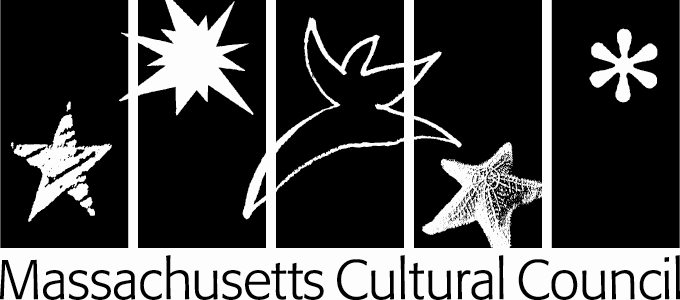
Propose a Case Study
Help us improve our Case Study library

